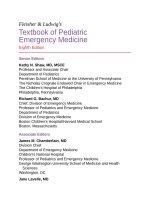Pediatric emergency medicine trisk 0307 0307
Bạn đang xem bản rút gọn của tài liệu. Xem và tải ngay bản đầy đủ của tài liệu tại đây (74.15 KB, 1 trang )
7. Needle cricothyrotomy capability and/or cricothyrotomy capability
(surgical cricothyrotomy can be performed in older children in whom the
cricothyroid membrane is easily palpable, usually by puberty)
8. Rescue airway devices for children
9. Atomizers for administration of intranasal medications
10. Umbilical vein catheters
11. Handheld blood analyzer (i-STAT)
12. Finger/heel lancets
13. Video laryngoscopes (GlideScope, C-MAC)
14. Inhaled nitric oxide setup
Optional medications
A. Optional medications for BLS emergency ambulances
1. Albuterol
2. EpiPen
3. Oral glucose
4. Nitroglycerin (sublingual tablet or paste)
5. Aspirin
B. Optional medications for ALS emergency ground ambulances
1. Intubation adjuncts, including neuromuscular blockers
Interfacility transport
Additional equipment may be needed by ALS and BLS out-of-hospital care
providers who transport patients between facilities. Transfers may be made to
a lower or higher level of care, depending on the specific need. Specialty
transport teams, including pediatric and neonatal teams, may include other
personnel, such as respiratory therapists, nurses, and physicians. Training and
equipment needs may be different depending on the skills needed during
transport of these patients. There are excellent resources available that
provide detailed lists of equipment needed for interfacility transfer, such as
Guidelines for Air and Ground Transport of Neonatal and Pediatric Patients
from the AAP and The Interfacility Transfer Toolkit for the Pediatric Patient
from the EMSC, ENA, and the Society of Trauma Nurses. Any ground
ambulance that, either by formal agreement or by circumstance, may be
called into service during a disaster or mass casualty incident to treat and/or
transport any patient from the scene to the hospital or to transfer between
facilities any patient other than those within their designated specialty
population should carry, at a minimum, all equipment, adult and pediatric,
listed under the “Required” sections as above.
Extrication equipment









